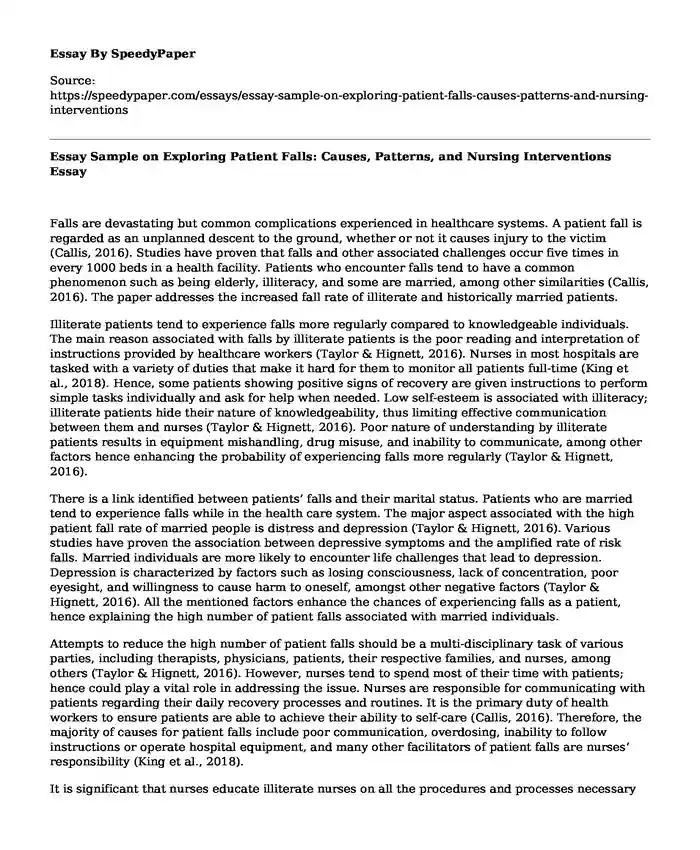
| Type of paper: | Essay |
| Categories: | Health and Social Care Nursing |
| Pages: | 3 |
| Wordcount: | 699 words |
Falls are devastating but common complications experienced in healthcare systems. A patient fall is regarded as an unplanned descent to the ground, whether or not it causes injury to the victim (Callis, 2016). Studies have proven that falls and other associated challenges occur five times in every 1000 beds in a health facility. Patients who encounter falls tend to have a common phenomenon such as being elderly, illiteracy, and some are married, among other similarities (Callis, 2016). The paper addresses the increased fall rate of illiterate and historically married patients.
Illiterate patients tend to experience falls more regularly compared to knowledgeable individuals. The main reason associated with falls by illiterate patients is the poor reading and interpretation of instructions provided by healthcare workers (Taylor & Hignett, 2016). Nurses in most hospitals are tasked with a variety of duties that make it hard for them to monitor all patients full-time (King et al., 2018). Hence, some patients showing positive signs of recovery are given instructions to perform simple tasks individually and ask for help when needed. Low self-esteem is associated with illiteracy; illiterate patients hide their nature of knowledgeability, thus limiting effective communication between them and nurses (Taylor & Hignett, 2016). Poor nature of understanding by illiterate patients results in equipment mishandling, drug misuse, and inability to communicate, among other factors hence enhancing the probability of experiencing falls more regularly (Taylor & Hignett, 2016).
There is a link identified between patients’ falls and their marital status. Patients who are married tend to experience falls while in the health care system. The major aspect associated with the high patient fall rate of married people is distress and depression (Taylor & Hignett, 2016). Various studies have proven the association between depressive symptoms and the amplified rate of risk falls. Married individuals are more likely to encounter life challenges that lead to depression. Depression is characterized by factors such as losing consciousness, lack of concentration, poor eyesight, and willingness to cause harm to oneself, amongst other negative factors (Taylor & Hignett, 2016). All the mentioned factors enhance the chances of experiencing falls as a patient, hence explaining the high number of patient falls associated with married individuals.
Attempts to reduce the high number of patient falls should be a multi-disciplinary task of various parties, including therapists, physicians, patients, their respective families, and nurses, among others (Taylor & Hignett, 2016). However, nurses tend to spend most of their time with patients; hence could play a vital role in addressing the issue. Nurses are responsible for communicating with patients regarding their daily recovery processes and routines. It is the primary duty of health workers to ensure patients are able to achieve their ability to self-care (Callis, 2016). Therefore, the majority of causes for patient falls include poor communication, overdosing, inability to follow instructions or operate hospital equipment, and many other facilitators of patient falls are nurses’ responsibility (King et al., 2018).
It is significant that nurses educate illiterate nurses on all the procedures and processes necessary for their recovery effectively. The health care workers should check the health records of all the patients under their care to ensure they understand and devise the most effective ways to facilitate their recovery (King et al., 2018). Nurses are expected to address the issue that prompted the admission of the patients by keeping them safe and aiding them to recover and maintain their mental and physical functioning. By building a healthy nurse-patient relationship, nurses can recognize depression or associated symptoms, especially in married or divorced patients (King et al., 2018). If nurses identify active symptoms of depression in patients, they could follow the necessary health recovery procedures to enhance their mental health. In addition, responsible health care workers handling such cases could handle the patients in question with required technicality hence avoiding fall occurrences (King et al., 2018).
References
Callis, N. (2016). Falls prevention: Identification of predictive fall risk factors. Applied Nursing Research, 29, 53-58. https://doi.org/10.1016/j.apnr.2015.05.007
King, B., Pecanac, K., Krupp, A., Liebzeit, D., & Mahoney, J. (2018). Impact of Fall Prevention on Nurses and Care of Fall Risk Patients. The Gerontologist, gnw156. https://doi.org/10.1093/geront/gnw156
Taylor, E., & Hignett, S. (2016). The SCOPE of Hospital Falls. HERD: Health Environments Research & Design Journal, 9(4), 86-109. https://doi.org/10.1177/1937586716645918
Cite this page
Essay Sample on Exploring Patient Falls: Causes, Patterns, and Nursing Interventions. (2023, Dec 20). Retrieved from https://speedypaper.com/essays/essay-sample-on-exploring-patient-falls-causes-patterns-and-nursing-interventions
Request Removal
If you are the original author of this essay and no longer wish to have it published on the SpeedyPaper website, please click below to request its removal:
- Essay Sample on the Universal Healthcare System in the U.S.
- Essay Example Comprising the Interview with a Terminally-Ill Patient
- Free Essay: Determinants of Health in Aboriginal and Torres Strait Islander Australians
- Free Essay Sample: Maggot Therapy Using Pico Model Problem
- Paper Example on Pathophysiology of Sickle Cell Disease
- Free Essay Example: Spiritual (Moral) Self
- Risks Alcohol Use Presents to Healthy Development During Pregnancy - Free Essay
Popular categories




